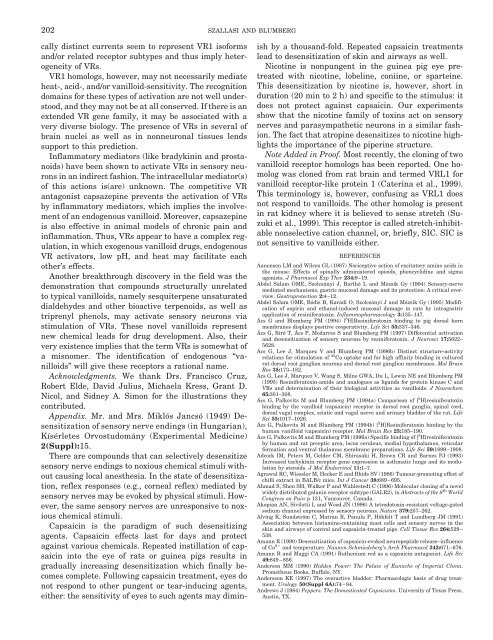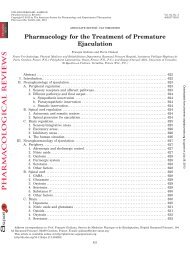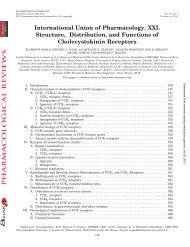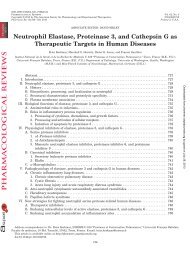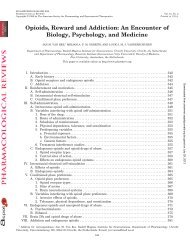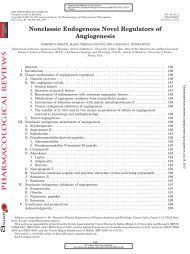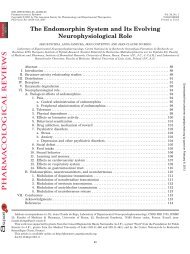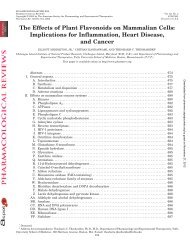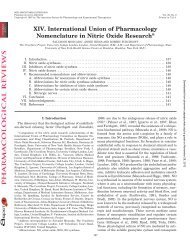Vanilloid (Capsaicin) Receptors and Mechanisms - Pharmacological ...
Vanilloid (Capsaicin) Receptors and Mechanisms - Pharmacological ...
Vanilloid (Capsaicin) Receptors and Mechanisms - Pharmacological ...
Create successful ePaper yourself
Turn your PDF publications into a flip-book with our unique Google optimized e-Paper software.
202 SZALLASI AND BLUMBERG<br />
cally distinct currents seem to represent VR1 isoforms<br />
<strong>and</strong>/or related receptor subtypes <strong>and</strong> thus imply heterogeneity<br />
of VRs.<br />
VR1 homologs, however, may not necessarily mediate<br />
heat-, acid-, <strong>and</strong>/or vanilloid-sensitivity. The recognition<br />
domains for these types of activation are not well understood,<br />
<strong>and</strong> they may not be at all conserved. If there is an<br />
extended VR gene family, it may be associated with a<br />
very diverse biology. The presence of VRs in several of<br />
brain nuclei as well as in nonneuronal tissues lends<br />
support to this prediction.<br />
Inflammatory mediators (like bradykinin <strong>and</strong> prostanoids)<br />
have been shown to activate VRs in sensory neurons<br />
in an indirect fashion. The intracellular mediator(s)<br />
of this actions is(are) unknown. The competitive VR<br />
antagonist capsazepine prevents the activation of VRs<br />
by inflammatory mediators, which implies the involvement<br />
of an endogenous vanilloid. Moreover, capsazepine<br />
is also effective in animal models of chronic pain <strong>and</strong><br />
inflammation. Thus, VRs appear to have a complex regulation,<br />
in which exogenous vanilloid drugs, endogenous<br />
VR activators, low pH, <strong>and</strong> heat may facilitate each<br />
other’s effects.<br />
Another breakthrough discovery in the field was the<br />
demonstration that compounds structurally unrelated<br />
to typical vanilloids, namely sesquiterpene unsaturated<br />
dialdehydes <strong>and</strong> other bioactive terpenoids, as well as<br />
triprenyl phenols, may activate sensory neurons via<br />
stimulation of VRs. These novel vanilloids represent<br />
new chemical leads for drug development. Also, their<br />
very existence implies that the term VRs is somewhat of<br />
a misnomer. The identification of endogenous “vanilloids”<br />
will give these receptors a rational name.<br />
Acknowledgments. We thank Drs. Francisco Cruz,<br />
Robert Elde, David Julius, Michaela Kress, Grant D.<br />
Nicol, <strong>and</strong> Sidney A. Simon for the illustrations they<br />
contributed.<br />
Appendix. Mr. <strong>and</strong> Mrs. Miklós Jancsó (1949) Desensitization<br />
of sensory nerve endings (in Hungarian),<br />
Kísérletes Orvostudomány (Experimental Medicine)<br />
2(Suppl):15.<br />
There are compounds that can selectively desensitize<br />
sensory nerve endings to noxious chemical stimuli without<br />
causing local anesthesia. In the state of desensitization,<br />
reflex responses (e.g., corneal reflex) mediated by<br />
sensory nerves may be evoked by physical stimuli. However,<br />
the same sensory nerves are unresponsive to noxious<br />
chemical stimuli.<br />
<strong>Capsaicin</strong> is the paradigm of such desensitizing<br />
agents. <strong>Capsaicin</strong> effects last for days <strong>and</strong> protect<br />
against various chemicals. Repeated instillation of capsaicin<br />
into the eye of rats or guinea pigs results in<br />
gradually increasing desensitization which finally becomes<br />
complete. Following capsaicin treatment, eyes do<br />
not respond to other pungent or tear-inducing agents,<br />
either: the sensitivity of eyes to such agents may dimin-<br />
ish by a thous<strong>and</strong>-fold. Repeated capsaicin treatments<br />
lead to desensitization of skin <strong>and</strong> airways as well.<br />
Nicotine is nonpungent in the guinea pig eye pretreated<br />
with nicotine, lobeline, coniine, or sparteine.<br />
This desensitization by nicotine is, however, short in<br />
duration (20 min to 2 h) <strong>and</strong> specific to the stimulus: it<br />
does not protect against capsaicin. Our experiments<br />
show that the nicotine family of toxins act on sensory<br />
nerves <strong>and</strong> parasympathetic neurons in a similar fashion.<br />
The fact that atropine desensitizes to nicotine highlights<br />
the importance of the piperine structure.<br />
Note Added in Proof. Most recently, the cloning of two<br />
vanilloid receptor homologs has been reported. One homolog<br />
was cloned from rat brain <strong>and</strong> termed VRL1 for<br />
vanilloid receptor-like protein 1 (Caterina et al., 1999).<br />
This terminology is, however, confusing as VRL1 does<br />
not respond to vanilloids. The other homolog is present<br />
in rat kidney where it is believed to sense stretch (Suzuki<br />
et al., 1999). This receptor is called stretch-inhibitable<br />
nonselective cation channel, or, briefly, SIC. SIC is<br />
not sensitive to vanilloids either.<br />
REFERENCES<br />
Aanonsen LM <strong>and</strong> Wilcox GL (1987) Nociceptive action of excitatory amino acids in<br />
the mouse: Effects of spinally administered opioids, phencyclidine <strong>and</strong> sigma<br />
agonists. J Pharmacol Exp Ther 234:9–19.<br />
Abdel Salam OME, Szolcsányi J, Barthó L <strong>and</strong> Mózsik Gy (1994) Sensory-nerve<br />
mediated mechanisms, gastric mucosal damage <strong>and</strong> its protection: A critical overview.<br />
Gastroprotection 2:4–12.<br />
Abdel Salam OME, Bódis B, Karádi O, Szolcsányi J <strong>and</strong> Mózsik Gy (1995) Modification<br />
of aspirin <strong>and</strong> ethanol-induced mucosal damage in rats by intragastric<br />
application of resiniferatoxin. Inflammopharmacology 3:135–147.<br />
Ács G <strong>and</strong> Blumberg PM (1994) [ 3 H]Resiniferatoxin binding to pig dorsal horn<br />
membranes displays positive cooperativity. Life Sci 55:337–346.<br />
Ács G, Bíró T,Ács P, Modarres S <strong>and</strong> Blumberg PM (1997) Differential activation<br />
<strong>and</strong> desensitization of sensory neurons by resiniferatoxin. J Neurosci 17:5622–<br />
5628.<br />
Ács G, Lee J, Marquez V <strong>and</strong> Blumberg PM (1996b) Distinct structure-activity<br />
relations for stimulation of 45 Ca uptake <strong>and</strong> for high affinity binding in cultured<br />
rat dorsal root ganglion neurons <strong>and</strong> dorsal root ganglion membranes. Mol Brain<br />
Res 35:173–182.<br />
Ács G, Lee J, Marquez V, Wang S, Milne GWA, Du L, Lewin NE <strong>and</strong> Blumberg PM<br />
(1995) Resiniferatoxin-amide <strong>and</strong> analogues as lig<strong>and</strong>s for protein kinase C <strong>and</strong><br />
VRs <strong>and</strong> determination of their biological activities as vanilloids. J Neurochem<br />
65:301–308.<br />
Ács G, Palkovits M <strong>and</strong> Blumberg PM (1994a) Comparison of [ 3 H]resiniferatoxin<br />
binding by the vanilloid (capsaicin) receptor in dorsal root ganglia, spinal cord,<br />
dorsal vagal complex, sciatic <strong>and</strong> vagal nerve <strong>and</strong> urinary bladder of the rat. Life<br />
Sci 55:1017–1026.<br />
Ács G, Palkovits M <strong>and</strong> Blumberg PM (1994b) [ 3 H]Resiniferatoxin binding by the<br />
human vanilloid (capsaicin) receptor. Mol Brain Res 23:185–190.<br />
Ács G, Palkovits M <strong>and</strong> Blumberg PM (1996a) Specific binding of [ 3 H]resiniferatoxin<br />
by human <strong>and</strong> rat preoptic area, locus ceruleus, medial hypothalamus, reticular<br />
formation <strong>and</strong> ventral thalamus membrane preparations. Life Sci 59:1899–1908.<br />
Adcock IM, Peters M, Gelder CM, Shirasaki H, Brown CR <strong>and</strong> Barnes PJ (1993)<br />
Increased tachykinin receptor gene expression in asthmatic lungs <strong>and</strong> its modulation<br />
by steroids. J Mol Endocrinol 11:1–7.<br />
Agrawal RC, Wiessler M, Hecker E <strong>and</strong> Bhide SV (1986) Tumour-promoting effect of<br />
chilli extract in BALB/c mice. Int J Cancer 38:689–695.<br />
Ahmad S, Shen SH, Walker P <strong>and</strong> Wahlestedt C (1996) Molecular cloning of a novel<br />
widely distributed galanin receptor subtype (GALR2), in Abstracts of the 8 th World<br />
Congress on Pain p 131, Vancouver, Canada.<br />
Akopian AN, Sivilotti L <strong>and</strong> Wood JN (1996) A tetrodotoxin-resistant voltage-gated<br />
sodium channel expressed by sensory neurons. Nature 379:257–262.<br />
Alving K, Sundström C, Matran R, Panula P, Hökfelt T <strong>and</strong> Lundberg JM (1991)<br />
Association between histamine-containing mast cells <strong>and</strong> sensory nerves in the<br />
skin <strong>and</strong> airways of control <strong>and</strong> capsaicin-treated pigs. Cell Tissue Res 264:529–<br />
538.<br />
Amann R (1990) Desensitization of capsaicin-evoked neuropeptide release–influence<br />
of Ca 2 <strong>and</strong> temperature. Naunyn-Schmiedeberg’s Arch Pharmacol 342:671–676.<br />
Amann R <strong>and</strong> Maggi CA (1991) Ruthenium red as a capsaicin antagonist. Life Sci<br />
49:849–856.<br />
Anderson MM (1990) Hidden Power: The Palace of Eunuchs of Imperial China.<br />
Prometheus Books, Buffalo, NY.<br />
Andersson KE (1997) The overactive bladder: Pharmacologic basis of drug treatment.<br />
Urology 50(Suppl 6A):74–84.<br />
Andrews J (1984) Peppers. The Domesticated Capsicums. University of Texas Press,<br />
Austin, TX.


